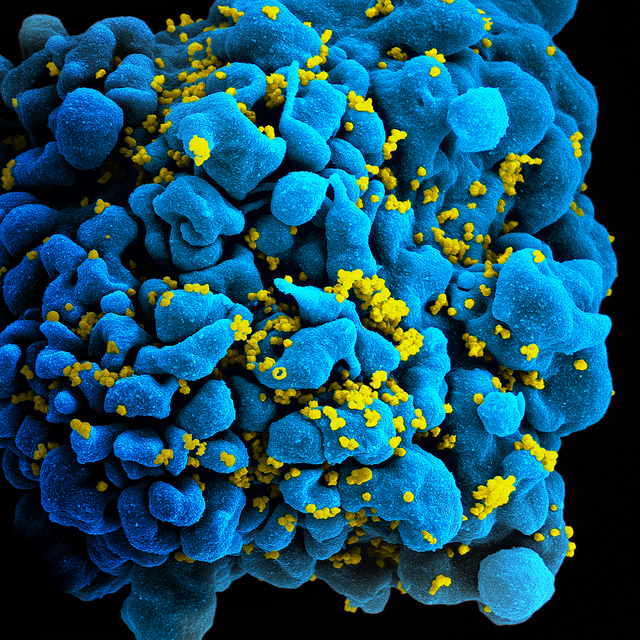Observing evolution in real time

HIV-infected T cell NIAID/flickr.com CC BY 2.0
To characterize the evolution and adaptation of HIV variants, the researchers analyzed the viral RNA from samples of HIV-infected patients for several years, using cutting-edge sequencing methods.
The scientists could show that the development of virus variants in each individual follows reproducible patterns. Certain regions of the virus accumulate mutations much faster than others: regions in the DNA that contain important functions for the virus reproduction vary less and almost all viruses from one sample have the same sequence at such sites.
At other sites of the genome, where mutations are not as detrimental for the virus, variation increases steadily and for a large fraction of these sites alternative variations circulate in the virus population. This diversity allows the viral population to adapt rapidly.
The viruses change at up to one percent of genome positions per year – this corresponds to the difference between human and chimpanzee. The frequent mutations help the virus to hide from the immune system – at the expense of the viral functionality. The scientists calculated the globally most frequent state for every site in the HIV genome.
They compared this global consensus sequence with the sequences from the patient samples. Surprisingly, 30 percent of all variations were reversions towards the consensus sequence. “One of our principal observations was that the virus has a kind of favourite sequence. The immune system pushes the virus away from this sequence. When the pressure of the immune system ceases, the viruses go back to this sequence”, explains Neher.
This happens for example when the virus is transmitted to another person, whose immune system recognizes other parts of the virus.
The results could also help to find vaccines against HIV: “Although HIV exists in many different strains, we found that the weak points of the virus are often the same in completely unrelated infections. One should now focus on these common weak points to develop vaccines”, says Fabio Zanini, first author of the study.
The development of HIV in the patients is also a good model to analyze general dynamics of evolution. In the case of HIV, the scientists can observe evolution directly from year to year and study processes that would take millions of years in other organisms.
Original Publication:
Population genomics of intrapatient HIV-1 evolution
http://dx.doi.org/10.7554/eLife.11282
Contents, including text, figures, and data, are free to reuse under a CC BY 4.0 license.
Contact:
Dr. Richard Neher
Mail: richard.neher@tuebingen.mpg.de
Nadja Winter (Pressereferentin)
Tel.: 07071 601-444
Mail: presse-eb@tuebingen.mpg.de
About us:
The Max Planck Institute for Developmental Biology conducts basic research in the fields of biochemistry, genetics and evolutionary biology. It employs about 360 people and is located at the Max Planck Campus in Tübingen. The Max Planck Institute for Developmental Biology is one of 83 research institutes that the Max Planck Society for the Advancement of Science maintains in Germany.
http://elifesciences.org/content/early/2015/12/11/eLife.11282
Media Contact
More Information:
http://eb.mpg.deAll latest news from the category: Life Sciences and Chemistry
Articles and reports from the Life Sciences and chemistry area deal with applied and basic research into modern biology, chemistry and human medicine.
Valuable information can be found on a range of life sciences fields including bacteriology, biochemistry, bionics, bioinformatics, biophysics, biotechnology, genetics, geobotany, human biology, marine biology, microbiology, molecular biology, cellular biology, zoology, bioinorganic chemistry, microchemistry and environmental chemistry.
Newest articles

A universal framework for spatial biology
SpatialData is a freely accessible tool to unify and integrate data from different omics technologies accounting for spatial information, which can provide holistic insights into health and disease. Biological processes…

How complex biological processes arise
A $20 million grant from the U.S. National Science Foundation (NSF) will support the establishment and operation of the National Synthesis Center for Emergence in the Molecular and Cellular Sciences (NCEMS) at…

Airborne single-photon lidar system achieves high-resolution 3D imaging
Compact, low-power system opens doors for photon-efficient drone and satellite-based environmental monitoring and mapping. Researchers have developed a compact and lightweight single-photon airborne lidar system that can acquire high-resolution 3D…





















